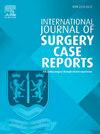主动脉手术后多处假性结核动脉瘤复发:病例报告。
IF 0.6
Q4 SURGERY
引用次数: 0
摘要
导言和重要性:结核性主动脉瘤需要严格的内科和外科治疗,因为各种并发症会对生命造成重大威胁,其中复发是最可怕的术后并发症之一。复发与大量出血和感染有关,从而增加了死亡风险。结核导致的动脉瘤累及所有动脉的情况都有记录,但发生在髂总动脉的情况罕见且严重,必须立即处理:本病例是一名 47 岁男性的病例,他曾因泌尿生殖系统结核接受过治疗,三年前因腹部并动脉瘤接受了主动脉旁路手术。患者因腹痛来到急诊室。急诊 CT 血管造影显示,搭桥术远端吻合处有一个假性动脉瘤,左侧髂总动脉也有一个新的假性动脉瘤。患者接受了手术,移除了旧的主动脉移植物,并使用达克隆移植物进行了新的主动脉-双侧髂旁路手术。对手术中采集的动脉样本进行的组织学分析证实了动脉瘤的结核病源,抗结核治疗延长了 6 个月。6 个月后,患者一般状况良好,搭桥手术也顺利完成:临床讨论:为了达到最佳效果,应先进行药物治疗,然后再进行手术治疗。在传统手术和血管内手术之间,每个病例的选择都是因人而异的。然而,血管内治疗无法对受感染的主动脉周围组织进行清创,因此感染恶化和复发的风险很高,有可能导致致命后果:有效的治疗需要在手术干预前进行抗结核治疗和抗生素治疗,以消除动脉瘤、控制术后结果并尽量减少结核相关并发症。这项工作的报告符合 SCARE 标准(Sohrabi 等人,2023 [17])。本文章由计算机程序翻译,如有差异,请以英文原文为准。
Recurrence of multiple localizations of false tuberculous aneurysms after aortic surgery: A case report
Introduction and importance
Tuberculous aortic aneurysms require rigorous medical and surgical management due to the various complications that pose a significant life risk, with recurrence being one of the most formidable postoperative complications. This recurrence is linked to significant hemorrhage and infection, subsequently increasing the risk of mortality. Aneurysmal involvement due to tuberculosis is documented and can affect all arteries, but localization in the common iliac artery is rare and serious, necessitating immediate management.
Case presentation
We present the case of a 47-year-old man who had previously been treated for urogenital tuberculosis and underwent an aorto-aortic bypass three years ago for a juxtarenal abdominal aneurysm. The patient presented to the emergency room with abdominal pain. An emergency CT angiogram revealed a pseudoaneurysm at the site of the distal anastomosis of the bypass and a new pseudoaneurysm of the left common iliac artery. The patient underwent surgery, which involved the removal of the old aortic graft and a new aorto-bilateral iliac bypass using a Dacron graft. Histological analysis of the arterial samples collected during the operation confirmed the tuberculous origin of the aneurysm, and antituberculous treatment was extended for six months. After six months, the patient was in good general condition, and the bypass was patent.
Clinical discussion
For optimal results, medical treatment should precede surgical intervention. The choice between conventional and endovascular surgery is individualized for each case. However, endovascular treatment does not allow for debridement of the infected periaortic tissues, which is associated with a high risk of progression and recurrence of the infection, potentially leading to a fatal outcome.
Conclusion
Effective management requires antituberculous treatment and antibiotic therapy prior to surgical intervention to eliminate the aneurysm, control postoperative outcomes, and minimize complications related to tuberculosis.
The work has been reported in line with the SCARE criteria (Sohrabi et al., 2023 [17]).
求助全文
通过发布文献求助,成功后即可免费获取论文全文。
去求助
来源期刊
CiteScore
1.10
自引率
0.00%
发文量
1116
审稿时长
46 days

 求助内容:
求助内容: 应助结果提醒方式:
应助结果提醒方式:


